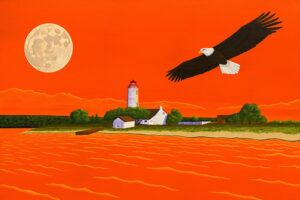A house made of stone and light

By Waab Shki Makoons (Clayton Samuel King)
BEAUSOLEIL FIRST NATION — Chimnissing (also referred to as Beausoleil First Nation and Christian Island) has been known for years for its beautiful beaches that are situated on the three islands within its territory, but not too many people know about the history of its lighthouse and the treaty that was made for its creation.
The Christian Island lighthouse was the first of six imperial lighthouses that were built on Georgian Bay. The construction of this lighthouse started in 1855 by John Brown of Thorold, Ont. He was hired by the Commissioners of Public Works for the Province of Canada, and he was commissioned to construct 11 lighthouses in Georgian Bay, but only six were created. The erection of The Christian Island Lighthouse and lighthouse keeper’s home was completed in 1856. It wasn’t until May 1, 1859, that a state-of-the-art argand lamp was fixed within a 4th order frensel lens in the lantern room that was situated on top of the 60-foot white cylindrical tower. The lantern room was created by the Louis Saultier Company of Paris France.
Like most projects being constructed at this time in central Ontario, the British Colonial Government didn’t have permission from the original proprietors of the area to utilize the land for this construction. Without consultation or approval from the leaders of the Chippewas of Lakes Huron and Simcoe bands, this project was well under way. The chiefs and headmen of the Chippewas of Lakes Huron and Simcoe were probably notified by the Potawatomi and Odawa who were residing on the island when the lighthouse construction began. It was on March 29, 1857, that the British Colonial Government had made a treaty with the chiefs and headmen of the Yellowhead, Assance, and Snake Bands to surrender 10 acres of land at Bar Point, Christian Island, for lighthouse purposes.
In 1863, the first lighthouse keeper William Hoar had made complaints to the Public Works Department that the fence that he put up for a garden had been continually torn down by members of the Assance Band because it was created beyond the limits of the 10 acres of land granted for lighthouse purposes.
To resolve this situation, the Superintendent of Lighthouses D.G. Smith had met with the Assance Band on December 16, 1863, to create an arrangement with the band. This arrangement had discussed the possibility of a second surrender at Bar Point for more land that surrounded the lighthouse perimeter. The discussions had allowed for the fence to remain up until a treaty could be negotiated. With nothing in writing regarding the fence, members of the Assance Band had continued to tear it down.
In 1865, D.G. Smith had recommended to the Department of Public Works that 20 acres of land should be purchased to extend the land mass for lighthouse purposes at Bar Point on Christian Island. Smith had proposed payment of 2 pounds per acre to the Christian Island Band. It was at Christian Island on June 26, 1866, that Pre-confederate Treaty #120 was agreed upon between the Assance Band and the Visiting Superintendent of Indian Affairs, William R. Bartlett. It was written in the treaty that an additional 25 ¾ acres of land would be surrendered for lighthouse purposes. The treaty was interpreted by Wesleyan Missionary Allen Salt, who was stationed on the island at this time. There was nothing written in the treaty regarding the amount of money associated with the purchase of the 25 ¾ acres. What was written in the treaty was that the moneys received from the sale would be invested, and that the interest money accruing from the investment would be paid annually or semi-annually to the band and their descendants.
Through correspondence from the Department of Marine and Fisheries to the Department of the Minister of the Interior in 1874, the two parties stated that no payment had been found for Treaty #120 and it was requested that a payment might be made at a rate of $10 per acre and interest of 6 per cent be added since 1866. It was referenced that $373.71 was the amount of principal and interest due on the 25 ¾ acres of land. It is not known whether if one department was paying another department for the land, or if it was the Canadian Government paying the Christian Island band. Further research is required.
The Christian Island Lighthouse was in service by lighthouse keepers for 66 years. The lighthouse keepers during this time period were Captain William Hoar (1857-1868), John H. Hoar (1868-1891), Allan Collins (1891-1914), and Thomas Marchildon (1914-1922). The Christian Island Lighthouse was decommissioned on April 1, 1922. During WWII, the lighthouse lantern room was torn down, and its iron was used for the war effort. A light beacon was put on the lighthouse by the Canadian Coast Guard in 1965. The lantern room was re-established on top of the lighthouse at the turn of the century, returning it to its original appearance.
On Saturday August 25, 2007, a commemorated plaque for the 150th anniversary of the Christian Island Lighthouse was unveiled by Dave Maynard, President of the Huronia Lighthouse Preservation Society. More than 100 people were present to witness this commemoration, including Chief Rodney Monague Jr. This plaque can be viewed on the door of the Christian Island Lighthouse.
The 60-foot Christian Island Imperial Lighthouse still stands today. Remnants of the exterior block wall of the lighthouse keeper’s residence is also visible as well. This is just one of several stories regarding the history of Chimnissing.


